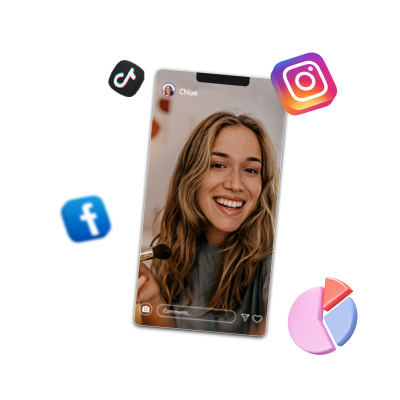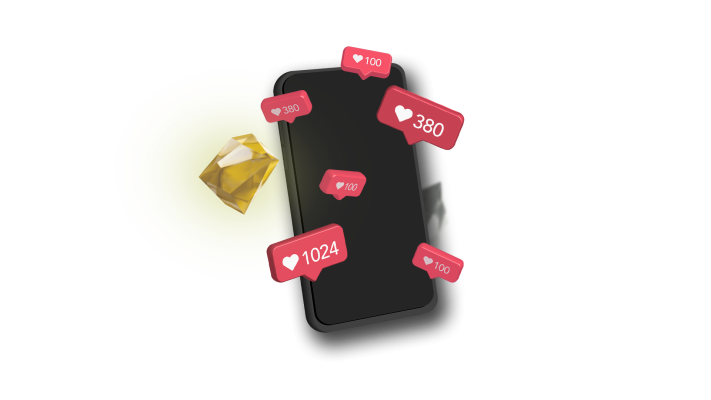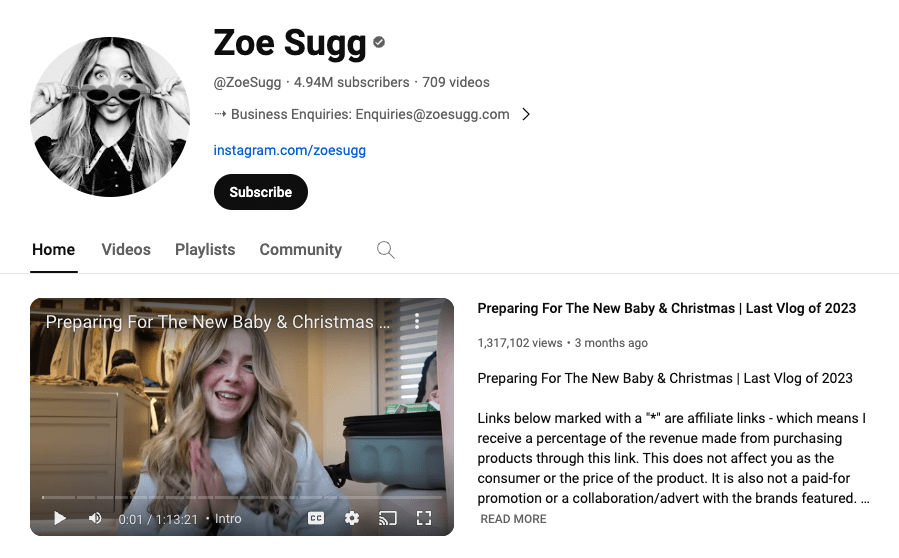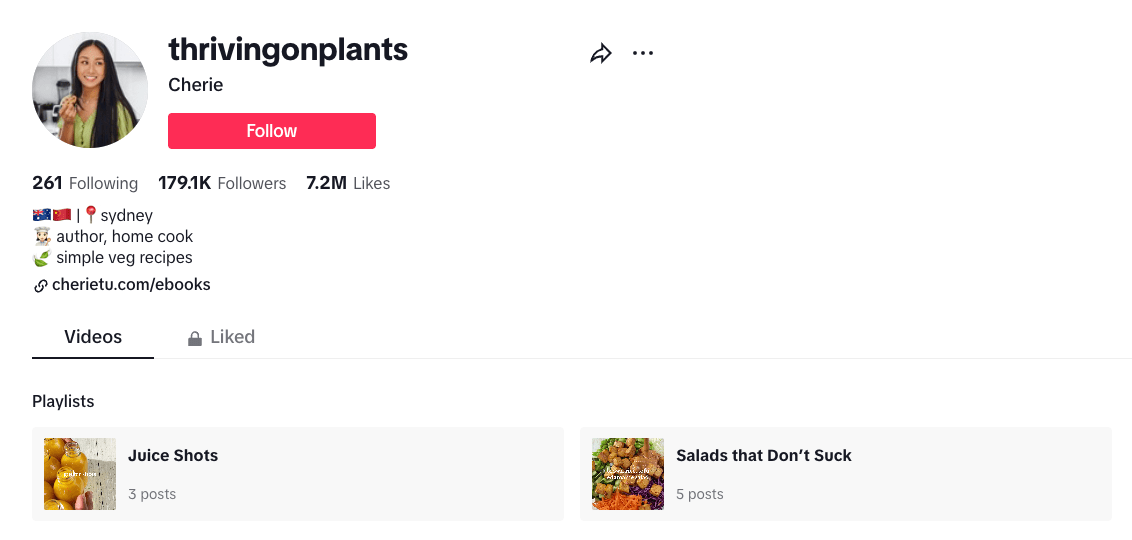10 Types of Influencers: Which Type Do You Need for Your Campaign?

Influencer marketing has evolved from a trend to a central component of modern digital strategies, offering unmatched potential for brand engagement and audience connection.
As the digital landscape becomes more saturated, the ability to cut through the noise and build meaningful relationships with your customers has never been more critical.
- Influencers, with their built-in audiences and trusted voices, offer a unique pathway to promote brand credibility, awareness, and, ultimately, sales.
However, navigating the world of influencers and finding the right ones for your campaign can be overwhelming, especially when considering follower counts and the different niches and industries they may fall into.
In this article, we’ll cover the ten types of influencers and how to choose the best one for your marketing campaign!
What is an Influencer?
Generally speaking, an influencer is someone who has the ability to impact the opinions, decisions, and actions of others within a specific niche or industry. They have built a reputation and following based on their expertise, knowledge, or unique perspective. Social media influencers use their platforms to develop self-brands, foster relationships, engage with followers, and share their knowledge in particular niches. The influencer’s follower count typically determines the category they belong to among the four we will discuss below.
Brands often employ influencers as ambassadors, promoters, partners, or simply to promote their products in creative ways. To learn more about working with influencers, check out our influencer campaign strategy guide.
What is Influencer Marketing?
Influencer marketing involves using influencers as part of your brand’s marketing campaign to promote a product, increase brand exposure, reach target consumers, hit certain KPIs, and more.
Looking for an Influencer Marketing Agency?
Our Influencer Marketing specialists are here to help you achieve success
Influencers and Mobile Marketing
While influencer marketing is traditionally considered as a digital marketing strategy, influencers can also play a significant role in mobile marketing by leveraging their influence and reach to promote mobile apps, products, and services. Here are some ways influencers can help promote your app:
- Increase brand awareness: Influencers have a dedicated following who trust their recommendations. By partnering with influencers, marketers can tap into their audience and increase brand visibility, reaching potential users who may not be aware of the app or product.
- Drive app downloads: you can utilize influencers to create engaging content around your app, showcasing its features and benefits. By sharing their experiences and opinions, they can encourage their followers to download and try out the app, which helps drive more app downloads.

- Boost user engagement: Influencers can help create buzz and excitement for your app through contests, giveaways, or challenges. Their active and engaged audience is more likely to participate, resulting in increased user engagement and interaction.
- Provide social proof: Influencers can contribute social proof for apps, vouching for their quality and effectiveness. When influencers recommend an app, their followers perceive it as a trusted recommendation, leading to increased trust and credibility for your brand.
- Target specific audiences: Influencers specialize in various niches and industries. By partnering with influencers relevant to your target audience, you can effectively reach and engage with a specific segment of mobile users, increasing the chances of conversion and retention.
Types of Influencers by Follower Count
There are four main different types of social media influencers, which can be defined by follower count:
- Nano Influencers – 1-10k followers
- Micro Influencers – 10-100k followers
- Macro Influencers – 100k-1 Million followers
- Mega Influencers – 1 Million+ followers
Let’s break down the different types of influencer by follower count:
1. What is a Nano Influencer?
Nano influencers are defined as having between 1k-10k followers on their social media channels. Their smaller audience does not mean their influence isn’t strong, as their followers are typically highly engaged and trust their opinion. Nano influencers foster a strong relationship with their followers, who they’re likely very connected to. As a result, their engagement rates tend to be high.
Often, nano influencers have a following within a particular community, whether that’s location-based, a specific online niche, or career-oriented.
When Should Your Brand Use Nano Influencers?
If you have a smaller budget but want to dip your toes into the successful world of influencer marketing, then yes, nano influencers are perfect for your brand. They’re less expensive than influencers with bigger followings, and their high engagement rates can bring excellent value to your brand. Nano influencers are also a cost-effective solution to testing your marketing within a new audience demographic.
In short, nano influencers can be relevant when you want to specifically target a particular user base relevant to a niche.
2. What is a Micro Influencer?
Micro influencers are defined as having between 10k-100k followers. Despite having a larger following than nano influencers, they still manage to maintain a similar “relatability” or “authenticity” factor. Which, in turn, means they still have high engagement rates. Often, micro influencers fall into a particular niche or influencer category that can be specific to a particular location, job, or hobby.

Micro influencers aren’t celebrities; they build their following based on high-value content and trust. Since people follow micro influencers for this closer relationship and the value they offer, they make for great brand ambassadors.
They produce content in a particular niche, so they’re often considered experts in this area. For a brand trying to access an audience in this niche, this can be invaluable. It can’t hurt to have a respected expert on board, can it?
When Should Your Brand Use Micro Influencers?
Brands should use micro-influencers if they are looking to take advantage of the creator’s “expert” status and close relationships with their followers for ultimate engagement. Micro influencers tend to have a following that is extremely interested in what they have to say, so your brand can benefit from their strong influence.
3. What is a Macro Influencer?
Macro influencers have between 100,000 to one million followers. Their reach is much larger than micro and nano influencers. Macro influencers are often content creators who have made careers out of their social media presence, making them ‘Internet famous.’ They could be bloggers, vloggers, podcasters, TikTok influencers, Instagram influencers, etc. What differentiates them from mega influencers is that their fame tends to arise from online growth rather than celebrity growth.
Macro influencers will have higher engagement levels than mega influencers but perhaps less engagement in a specific niche than nano or micro influencers.
When Should Your Brand Use Macro Influencers?
Consider engaging macro influencers when aiming to boost brand awareness through exposure campaigns on a moderate budget. Opting for macro influencers, instead of mega influencers, can provide a balance of exposure and engagement.
Looking to Boost Your Influencer Marketing Game?
Our Influencer Marketing specialists are here to help you achieve success.
Micro vs Macro Influencers
First and foremost, micro influencers have a smaller following than macro influencers. Beyond that, micro influencers also tend to be more invested in their audience. Perhaps it has to do with the size being more manageable, the effort to grow, or their following being dependent on that feeling of a personal relationship.
Because of this, they often have a stronger influence over their audience and can be more effective at driving results as part of an influencer marketing campaign, especially within a specific vertical or demographic.
4. What is a Mega Influencer?
Mega influencers have more than one million followers and are usually celebrities with a large online following. Due to their celebrity status and huge following, they tend to be expensive to work with.
What’s more, their audience is too large to be operating within one single niche, so their audience will be broad and span numerous demographics and interests. As such, their value for your brand may not be as high as micro-influencers, for example.

It’s generally accepted that mega influencers’ fame outweighs their genuine influence. People follow them because they are famous, not necessarily because they have fostered a close relationship with them and trust their opinion. Their volume of followers makes it hard to develop these close relationships and a higher level of engagement.
For example, the Kardashian / Jenner family would be considered mega influencers as all their follower counts are in the tens of millions. However, they rose to fame from their family’s hit reality TV show rather than from posting content on social media, which came secondary to their TV fame.
Mega influencers have a huge reach, garnering tens of millions of likes and views. While their massive reach may sound like a great selling point, it may be hard to determine how much of it will come from your target users or how many people are actually influenced to make a purchase.
When Should Your Brand Use Mega Influencers?
Brands should choose mega influencers when aiming for wide-reaching brand awareness, launching new products, or targeting mainstream markets.
These influencers, with their extensive follower base, are ideal for creating buzz, elevating brand positioning, and highlighting special events or launches.
However, these collaborations are best pursued when the budget allows for high-profile endorsements and when there’s a strategic alignment between the influencer’s image and the brand’s values to ensure authenticity and resonance with the target audience.
Types of Influencers By Industry or Niche
1. Lifestyle & Vloggers
Lifestyle and vloggers offer a mix of content, from travel to home decor, personal routines, and relationship advice, making them perfect for brands targeting diverse audiences.
Their versatility allows them to seamlessly promote various products and services within their content, meaning they are not limited to a single industry or niche.
These types of influencers also excel at creating relatable and engaging content that boosts brand visibility and fosters community.
- It’s important to note that some of these influencers have transitioned from being known for a specific niche to becoming full-time vloggers, so they may lean more toward one influencer category – which can be advantageous to leverage for your brand.

For instance, Zoe Sugg (also known as “Zoella” online), became famous on YouTube by creating beauty and fashion videos, but has since become a renowned vlogger, sharing her family life and relationship advice. Capitalizing on her broad reach, many lifestyle, beauty, and fashion brands have promoted their products and services through her channel.
2. Tech & Gaming
Tech and Gaming influencers provide expert insights on the latest gadgets and video games, attracting audiences interested in the newest advancements in tech and gaming.
However – their appeal isn’t just limited to their niche. Due to the strength of their personal brands, they can effectively engage audiences across various interests, making them valuable for promoting a wide range of products and services.
For instance, gaming influencers are often sponsored by food delivery services like Factor75 or HelloFresh, tapping into gamers’ needs for quick and easy meal solutions.
- Marques Brownlee, known as MKBHD, is a key influencer in the tech space. With over 18 million followers, he is well-known for his in-depth tech product reviews and analyses on YouTube.
Many of the largest tech brands such as Apple and Samsung, often send him their products to review, and viewers typically perceive him as the go-to source for finding an honest review of the newest products.

For the gaming niche, we can look at Austin John Plays, known for his extensive guides and reviews of the latest Nintendo Switch games on YouTube. He also streams these games on Twitch to over 100K followers, revealing exclusive gaming tips and tricks to his audience.
Looking for an Influencer Marketing Agency?
Our Influencer Marketing specialists are here to help you achieve success
3. Beauty & Fashion
Beauty & Fashion influencers dictate the latest trends in makeup, skincare, and style, deeply influencing how their followers perceive their personal style and overall aesthetics.
These types of influencers typically create a mix of content that ranges from makeup tutorials, skincare routines, fashion hauls, and styling tips, to discussions about sustainability in fashion and beauty.
Their content is not just about showing the latest trends but also about instilling confidence in their audience, teaching them how to express themselves through fashion and beauty.
This trait makes them unique in the influencer marketing space, as their ability to create a personal connection with their audience makes their recommendations feel more genuine and trustworthy.
And in case it wasn’t clear by now – authenticity is the key for influencer marketing success.
A prime example of a Beauty & Fashion influencer who embodies this blend of informative content and personal touch is The Anna Edit.
- Known for her minimalist style and approachable beauty advice, Anna has carved out a niche for herself among those seeking practical, stylish, and sustainable fashion and beauty options.

- Anna shares a wide range of content, including capsule wardrobe selections, beauty product reviews, and lifestyle tips, making her and similar influencers in her niche an influential voice for brands interested in promoting a balanced and aesthetic-driven lifestyle using their products.
4. Business & Finance
Business & Finance influencers share insights on investments, entrepreneurship, and financial planning, catering to an audience seeking expert advice.
Their advice ranges from how to manage daily expenses to how to plan for your financial future. They are often trusted because they share their own money wins and fails, making their advice feel real and doable.
A great example of these types of influencers is The Financial Diet. With over 1 million followers on YouTube, the channel focuses on personal financial experiences to teach its audience on how to make better choices in a friendly and direct manner, making it a popular go-to choice for financial advice.
Because their audience is mostly directed toward beginners and inexperienced people when it comes to finance, they are often sponsored by financial apps and services such as Betterment, which helps with managing personal finances and becoming a better investor.
- This approach not only simplifies financial management for their audience but also opens up opportunities for brands to introduce products and services that can aid in personal finance and investment, appealing to those just starting on their financial journey.
Depending on the level of expertise your product or service requires to use, leveraging these types of influencers can be highly beneficial in driving sales and increasing conversion rates for your brand. Their ability to convey complex financial concepts in an understandable and engaging way makes them invaluable partners for brands looking to connect with audiences new to personal finance, thereby enhancing brand visibility and trust.
5. Food & Nutrition
Food & Nutrition influencers engage audiences with cooking tips, restaurant reviews, and healthy eating advice. Their platforms can serve as a bridge between brands and a diverse audience hungry for food inspiration and wellness insights.
For businesses within the food industry, whether that’s gourmet brands, innovative food services, or even companies specializing in the latest kitchen gadgets, these influencers offer a flavorful avenue for brand promotion.
Their ability to create content that resonates with food lovers and health-conscious individuals alike makes them invaluable for marketing strategies aiming to generate interest for food-related products and services.
Taking Cherie from Thriving on Plants on TikTok as a case in point, her approach to sharing vibrant, straightforward veggie recipes has captivated millions. Her success lies in her ability to make healthy eating appealing and accessible, transforming simple ingredients into visually stunning dishes that beg to be tried.

Her viral videos demonstrate the power of Food & Nutrition influencers to impact food choices and preferences, showcasing their potential as partners for brands looking to connect with food enthusiasts and the health-conscious market.
6. Health & Wellness
Health & Wellness influencers focus on inspiring their audiences towards a holistic approach to health, emphasizing both physical fitness and mental well-being. They make health and wellness accessible and engaging, offering insights into effective fitness routines, mental health strategies, and overall wellness tips.
These types of influencers are key for brands within the health, fitness, and wellness industries aiming to connect with an audience actively seeking ways to improve their health.
They can seamlessly integrate products or services into their content, from workout equipment and wellness apps to nutritional supplements, providing genuine recommendations that resonate with their followers. This authenticity boosts brand visibility and trust, translating into increased engagement and potential sales.
- For instance, influencers in this space can demonstrate the use of fitness gear in their workout routines or highlight the benefits of health supplements in their nutrition advice, effectively showcasing product relevance and benefits in a real-world context.
A notable example is Cassie of Blogilates, who has successfully built a large community around accessible workouts you can do at the comfort of your home. Her approach highlights how Health & Wellness influencers can foster a dedicated following by providing valuable content that directly impacts the audience’s lifestyle choices and well-being.
How to Choose the Right Influencer for Your Brand
The answer to this question will depend on the goals of your campaign and your budget. Is it a brand awareness campaign? Then perhaps a mega influencer might be the answer as they’ll have the biggest reach.
Do you have a small budget? In that case, you probably can’t afford a mega-influencer, and a nano-influencer or micro-influencer might be the way to go.
Consider how many followers the influencer has, their engagement rate (which you can ask them for), and whether working with your brand would look authentic for both you and them, as authenticity is key in influencer marketing. You need to also consider whether your campaign goals align with what the type of influencer can achieve for you – brand awareness, conversions, etc.
Make sure to take the influencer’s main platform into account as well. A YouTube vlogger is going to offer different potential for showcasing your app than micro influencers on Instagram because the content they create is a totally different format.
So ask yourself the following: Would your product or service come across better in the mostly visual or short form video style of Instagram and TikTok, or would it look better in a long form YouTube vlog?
Where to Find the Best Influencers
There are various influencer marketing tools and platforms that can help you find the right influencers for your brand and campaign. You can also keep tabs on influencers that already post about your brand or competitors. Or, find influencers who have an audience base that overlaps with your target user base.
However, we recommend hiring an expert influencer marketing agency like Moburst to help you master the entire marketing funnel.
At Moburst, our Creator Network boasts a diverse array of influencers spanning every industry, ready to help you achieve your goals and KPIs effectively.
Looking for an Influencer Marketing Agency?
Our Influencer Marketing specialists are here to help you achieve success.
Frequently Asked Questions (FAQs)
Simply put, an influencer is someone who shares content on social media and has the ability to use their knowledge, authority, audience relationships etc. to influence the purchases of others. This can be on any platform ranging from TikTok to Facebook, and their followings can vary in size from one thousand to one million.
In order of following (from largest to smallest), there are: mega influencers, macro influencers, micro influencers and nano influencers. There are also types of influencers by industry and niche such as gaming & tech, health & wellness, etc.
Mega influencers have more than 1 million followers, macro influencers have between 100,000 to 1 million followers, micro-influencers have between 10,000 to 100,000 followers and nano influencers have between 1,000 to 10,000 followers.
AI influencers are virtual personalities created using artificial intelligence. They’re not real people but digital avatars that engage audiences on social media, often representing brands in a controlled and consistent way.
There are five main types based on follower count: nano, micro, mid-tier, macro, and mega influencers. Each type offers a different balance of reach, engagement, and cost. However, you can also categorize types of influencers by industry or niche, which there are plenty of.
A niche influencer is someone who specializes in a specific topic or industry, creating content for a highly targeted and engaged audience.
Nano and micro-influencers are ideal for small businesses because they tend to have high engagement rates and are more affordable to work with.
Large businesses often benefit from working with mid-tier, macro, or mega influencers due to their wide reach and brand visibility potential.
Smaller influencers are cost-effective and engaging but offer limited reach, while larger influencers provide broader exposure at a higher cost, often with lower engagement. The choice depends on campaign goals and budget.






